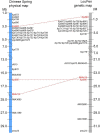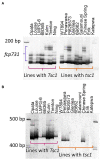Genomic Analysis and Delineation of the Tan Spot Susceptibility Locus Tsc1 in Wheat
- PMID: 35401609
- PMCID: PMC8984248
- DOI: 10.3389/fpls.2022.793925
Genomic Analysis and Delineation of the Tan Spot Susceptibility Locus Tsc1 in Wheat
Abstract
The necrotrophic fungal pathogen Pyrenophora tritici-repentis (Ptr) causes the foliar disease tan spot in both bread wheat and durum wheat. Wheat lines carrying the tan spot susceptibility gene Tsc1 are sensitive to the Ptr-produced necrotrophic effector (NE) Ptr ToxC. A compatible interaction results in leaf chlorosis, reducing yield by decreasing the photosynthetic area of leaves. Developing genetically resistant cultivars will effectively reduce disease incidence. Toward that goal, the production of chlorosis in response to inoculation with Ptr ToxC-producing isolates was mapped in two low-resolution biparental populations derived from LMPG-6 × PI 626573 (LP) and Louise × Penawawa (LouPen). In total, 58 genetic markers were developed and mapped, delineating the Tsc1 candidate gene region to a 1.4 centiMorgan (cM) genetic interval spanning 184 kb on the short arm of chromosome 1A. A total of nine candidate genes were identified in the Chinese Spring reference genome, seven with protein domains characteristic of resistance genes. Mapping of the chlorotic phenotype, development of genetic markers, both for genetic mapping and marker-assisted selection (MAS), and the identification of Tsc1 candidate genes provide a foundation for map-based cloning of Tsc1.
Keywords: Ptr ToxC; Pyrenophora tritici-repentis; Triticum; Tsc1; disease resistance; tan spot; wheat.
Copyright © 2022 Running, Momotaz, Kariyawasam, Zurn, Acevedo, Carter, Liu and Faris.
Conflict of interest statement
The authors declare that the research was conducted in the absence of any commercial or financial relationships that could be construed as a potential conflict of interest.
Figures





Similar articles
-
Genetic relationships between race-nonspecific and race-specific interactions in the wheat-Pyrenophora tritici-repentis pathosystem.Theor Appl Genet. 2016 May;129(5):897-908. doi: 10.1007/s00122-016-2670-x. Epub 2016 Jan 21. Theor Appl Genet. 2016. PMID: 26796533
-
Association Mapping of Resistance to Tan Spot in the Global Durum Panel.Phytopathology. 2023 Oct;113(10):1967-1978. doi: 10.1094/PHYTO-02-23-0043-R. Epub 2023 Nov 10. Phytopathology. 2023. PMID: 37199466
-
A Conserved Hypothetical Gene Is Required but Not Sufficient for Ptr ToxC Production in Pyrenophora tritici-repentis.Mol Plant Microbe Interact. 2022 Apr;35(4):336-348. doi: 10.1094/MPMI-12-21-0299-R. Epub 2022 Mar 14. Mol Plant Microbe Interact. 2022. PMID: 35100008
-
Genetics of tan spot resistance in wheat.Theor Appl Genet. 2013 Sep;126(9):2197-217. doi: 10.1007/s00122-013-2157-y. Epub 2013 Jul 25. Theor Appl Genet. 2013. PMID: 23884599 Review.
-
Host-selective toxins, Ptr ToxA and Ptr ToxB, as necrotrophic effectors in the Pyrenophora tritici-repentis-wheat interaction.New Phytol. 2010 Sep;187(4):911-9. doi: 10.1111/j.1469-8137.2010.03362.x. Epub 2010 Jul 14. New Phytol. 2010. PMID: 20646221 Review.
Cited by
-
Molecular-based race classification of Pyrenophora tritici-repentis causing tan spot of wheat in Japan.Breed Sci. 2023 Dec;73(5):445-449. doi: 10.1270/jsbbs.23012. Epub 2023 Oct 28. Breed Sci. 2023. PMID: 38737920 Free PMC article.
-
Genome-wide association mapping of resistance to the foliar diseases septoria nodorum blotch and tan spot in a global winter wheat collection.Mol Breed. 2023 Jun 17;43(7):54. doi: 10.1007/s11032-023-01400-5. eCollection 2023 Jul. Mol Breed. 2023. PMID: 37337566 Free PMC article.
References
-
- Ballance G. M., Lamari L., Kowatsch R., Bernier C. C. (1996). Cloning, expression and occurrence of the gene encoding the Ptr necrosis toxin from Pyrenophora tritici-repentis. Mol. Plant Pathol. doi: 10.1007/978-94-011-5218-1_21 - DOI
-
- Carter A. H., Chen X. M., Garland-Campbell K., Kidwell K. K. (2009). Identifying QTL for high-temperature adult-plant resistance to stripe rust (Puccinia striiformis f. sp. tritici) in the spring wheat (Triticum aestivum L.) cultivar ‘Louise’. Theor. Appl. Genet. 119, 1119–1128. doi: 10.1007/s00122-009-1114-2, PMID: - DOI - PubMed
-
- Carter A. H., Kidwell K. K., DeMacon V. L., Shelton G. B., Burke A. B., Balow K. A., et al. . (2020). Registration of the Louise-Penawawa spring wheat recombinant inbred line mapping population. J. Plant Regist. 14, 474–480. doi: 10.1002/plr2.20077 - DOI
LinkOut - more resources
Full Text Sources
Research Materials
Miscellaneous

